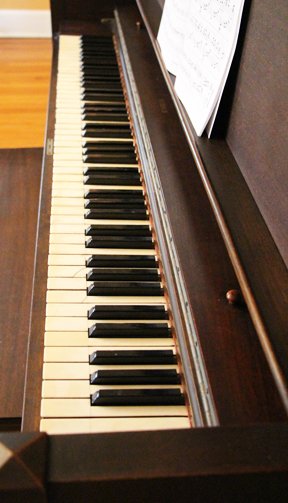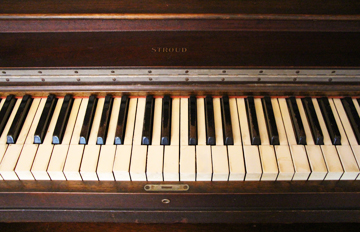Music: Finely Tuned
By Mary Ann Ebner
arttimes online July 16
|
Some people like the sound of conversation, others silence, and some of us love the sound of music. When I started searching for a used piano, my dream wasn’t to produce another “Baby Mozart” but I hoped to share an appreciation of music with my sons. Buying a used piano seemed innocent enough and not terribly extravagant. I’d grown up crowding around a tiny electronic organ with my siblings. The instrument didn’t put out much volume but we made the most of it learning to play simple arrangements.
My husband, Greg, who appreciates music, didn’t care to jump on the piano bench bandwagon. He’s all in when it comes to reliving his visits to Carnegie Hall, but when I mentioned one particular used piano, only to learn that the instrument had already been sold, he was relieved. He seemed to think of a piano as one more piece of furniture and not as a treasure to enjoy as I considered the acquisition. In his mind, buying a used piano meant calling a friend to help move the load. He’s a man who respects friends and won’t risk losing one to a back injury.
I continued the search and found a “beauty” listed in a neighboring community but my call came too late. Same for a seasoned spinet, which appeared to be a “wonderful bargain.” But one harmonious morning, I spotted an ad, and placed a call for an upright Stroud, with “excellent tone, $175.” The owner, Mr. Chang, answered and announced no sale had yet occurred. Mr. Chang, retired from the United Nations, praised the virtues of the old Stroud and added some history. “By the way,” he said, “Kofi Annan actually sat around this piano and sang with us.”
Not only would we acquire excellent tone — if his words proved true — we’d acquire United Nations history.
I made an appointment and decided to bring the whole family. I could hardly wait.
On our way to the Changs’ cottage tucked away in the forest, Greg and I established a code. I would ask if he thought the piano would fit into our space. If he said no, he wanted no part of this transaction. If yes, he agreed the piano had hope. Once we arrived, I held my breath when I saw the upright. It looked huge. I asked, “Honey, do you think we can squeeze it into our place?”
“Maybe,” he said, deviating completely.
Mrs. Chang, who had been listening quietly, broke in with, “Why don’t we just give it to you?”
We accepted the piano and told the Changs that it was contingent on professional movers agreeing to handle the job.
Once the moving team was able to wrestle the Stroud down the stairs at the cottage and load it, they still had to maneuver their industrial-size vehicle into a tight turn to head back down the gravel mountain road. They didn’t even blink when they saw the 14 stairs leading to our door. Dripping in sweat with a back-breaking load, they wedged the treasure into its new home — our narrow dining room. I sang praises for the movers. The upright needed a thorough cleaning, and I displaced a family of spiders when I dusted it spotless. We traced the serial number, 55920, to the Aeolian Company of New York, which manufactured the piano parts around 1920.
|
Our tuner did his best to help prolong our piano’s life, and we found a music teacher willing to instruct our boys without showing any signs of hesitation about the instrument’s age and condition.
Shortly after the piano rescue, a note arrived from Mrs. Chang: “I hope the piano turns out satisfactorily and your boys enjoy learning on it as our kids did.”
We enjoyed the gift of music as our sons prepared and practiced each new piano piece through their elementary and middle school years. But then additional instruments began to make their way into our home. First it was the snare drum, which led to the trap set. Next we picked up an old euphonium for our older son. With more music in our future, our younger son then came home from school with a baritone only to be followed by his brother with a tuba. Next came the electronic keyboard and we expected that was that until the brothers collaborated on the purchase of a plastic trombone that they insisted they would learn to play over the summer when they didn’t have too much school work. And they continued with piano but the Stroud finally took its last tune.
When the tuner delivered the news, our seventh grader wasn’t torn. He’d grown more comfortable playing low brass in the school band. He was relieved, thinking he’d graduated to a life of more free time. He even offered to post the piano’s parts for sale online. Though I appreciated his enthusiasm to help out, I assured him that we would try to find another piano. Our eighth grader though, was all for replacing the Stroud, and wouldn’t settle for another vintage model. He wanted something newer but couldn’t part with the tired upright, dropped keys and all. He knew the piano would no longer take a tune, but the old instrument had provided his introduction to playing and he found himself seated at its keys more than anyone in the family. Under no circumstances would he sanction discarding it for vintage parts, art projects or worse — the dump.
So the Changs’ piano remains in our dining room, and we found a spot in the living room for the replacement piano, a contemporary Yamaha upright.
When we hear our sons playing or catch them humming the rhythm of Mozart’s “Eine Kleine Nachtmusik” or the theme song from “James Bond,” we send best wishes to the Chang family who not only helped us fill our home with the sound of music, but with an assorted collection of instruments inspired by old ivory keys.
Mary Ann Ebner lives in the Hudson Valley and writes about food, family and the arts.
Share |


